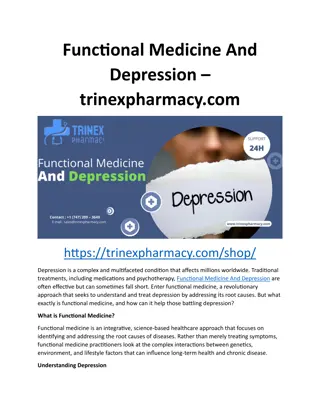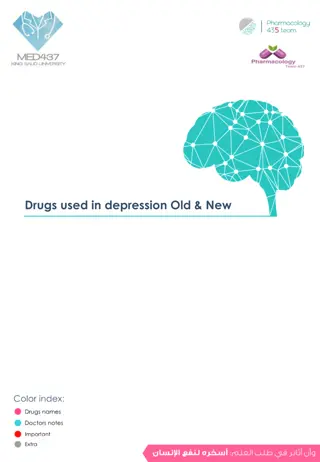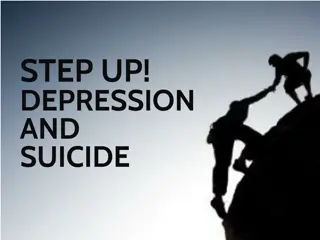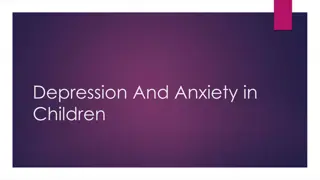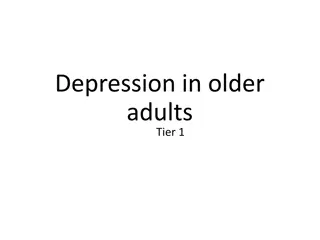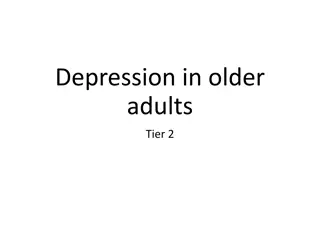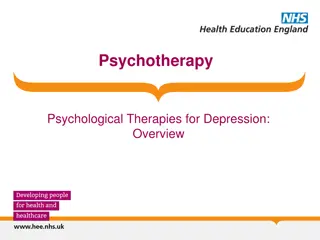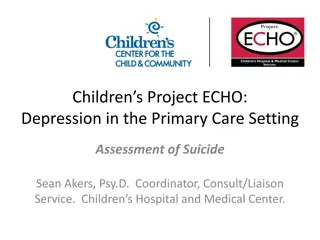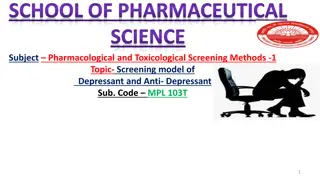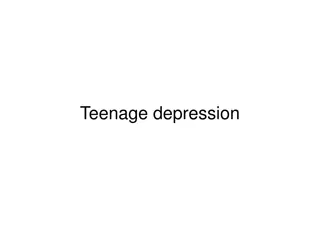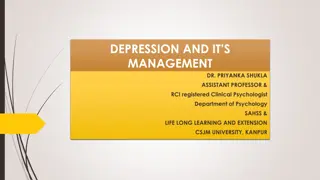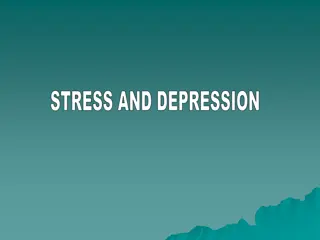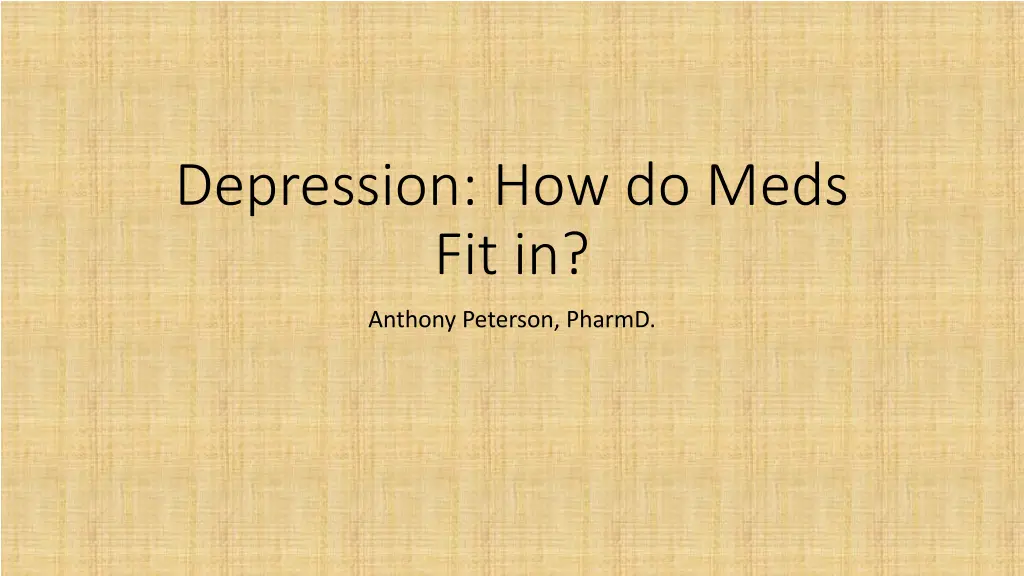
Understanding Depression Treatment Options
Learn about the basics of depression, including identification and assessment, medication considerations, and treatment options such as pharmacotherapy and nonpharmacologic interventions. Discover how medications fit into the treatment plan and the importance of combining therapy approaches for effective management. Explore the role of clinical pharmacists in medication history assessment and the potential adverse effects of certain substances. This comprehensive guide provides insights into managing depression through a holistic approach tailored to individual needs.
Uploaded on | 1 Views
Download Presentation

Please find below an Image/Link to download the presentation.
The content on the website is provided AS IS for your information and personal use only. It may not be sold, licensed, or shared on other websites without obtaining consent from the author. If you encounter any issues during the download, it is possible that the publisher has removed the file from their server.
You are allowed to download the files provided on this website for personal or commercial use, subject to the condition that they are used lawfully. All files are the property of their respective owners.
The content on the website is provided AS IS for your information and personal use only. It may not be sold, licensed, or shared on other websites without obtaining consent from the author.
E N D
Presentation Transcript
Depression: How do Meds Fit in? Anthony Peterson, PharmD.
Depression: The Basics Identification Major Depressive Disorder (MDD) Unipolar Depression DSM-V: diagnosed when at least 5 keystone symptoms present every day for at least two weeks and must interfere with daily life Depressed mood or anhedonia (little interest in desirable activities) required Persistent Depressive Disorder Persistent depressed mood for more days than not for over 2 years DOES NOT meet requirements for MDD
Depression: More of the Basics Assessment Psych History: Important in ruling out other possible psychiatric causes Clinician Rating Scales HAM-D, CGI, MADRS Patient Assessment Scales PHQ-9: most common in primary care settings, easy to administer Others include Beck Depression Inventory, GDS, etc. Physical Assessment Rule out physical causes that act like depression (thyroid, vitamin abnormalities) Medications and Substance Use History Always screen for suicidal thoughts
Depression: The Basics Medications and Substance Use History Key place for clinical pharmacist to perform thorough history Many meds can have depression as an adverse effect Interferons (cancer and hepatitis) Benzodiazepines (alprazolam, lorazepam, etc.) Barbituates(phenobarbital, Fioricet) Alcohol Central Nervous System Blockers (pain meds, etc.) Certain beta-blockers (nadolol, metoprolol, propranolol) Stimulant withdrawal (including cocaine, methamphetamine)
Treatment Nonpharmacologic Options Interpersonal psychotherapy and CBT just two examples Not as quick as pharmacotherapy alone Longer lasting effect than pharmacotherapy alone Recommended monotherapy for mild-to-moderate cases Combine with pharmacotherapy for moderate-to-severe-cases
Treatment Pharmacotherapy Based on findings that depressed patient have less available serotonin and dopamine levels Should try and use in conjunction with nonpharmacologic modalities Often quicker response, but not as long lasting Stopping pharmacotherapy can cause adverse effects and relapse in depressive symptoms ECT Only used in cases where both pharmacologic and non-pharmalogical modalities have failed or not appropriate for patient
Pharmacotherapy Treatment Phases Acute 12 weeks with goal of remission 3 weeks of no sx Onset Early response (2-4 weeks) good predictor of remission Monitoring Interview and repeat rating scales Also important for pharmacist to educate on possible SE to empower patient when reporting Nonresponders After adequate trial (4-8 weeks) and no response, can switch to other drug in same class or in different class Maintenance Remission achieved: treatment should continue for 6-9 months Risk factors for recurring depression: 2 years minimum Recurring episodes, severe episodes, comorbid psych conditions, etc.
SSRIs(Selective Serotonin Reuptake Inhibitors) Increased serotonin concentrations All equally efficacious Choice is very patient specific Adverse effect profiles are different May switch easily between drugs in same class Characteristic Half-Life Usual Dose (mg/day) Max Dose (mg/day) Fluoxetine 1-4 Days 20-60 Sertraline 26 hrs 50-200 Paroxetine Citalopram 32 hrs 20-40 Escitalopram 27-32 hrs 10-20 21 hrs 10-60 80 mg 200 50 (depression)/ 60(anxiety) 40(due to heart ) 20
Adverse Effects Interesting Points Fluoxetine, sertraline most activating Paroxetine, fluvoxamine most sedating Sexual dysfunction in up to 50% Possible increase in risk of bleeding
SNRIs(Serotonin/Norepinephrine Reuptake Inhibitors) Works to increase both serotonin and norepinephrine available Include Duloxetine(Cymbalta)-Also approved for neuropathy and other pain issue Venlafaxine(Effexor) Desvenlafaxine(Pristiq) Milnacipran- (Savella)-only approved for fibromyalgia Levomilnacipran(Fetzima) General side effects similar to SSRIs Venlafaxine and Desvenlafaxine Other Uses: GAD, Social Anxiety Disorder, PTSD, Incontinence
Serotonin Syndrome Potentially life-threatening condition where the excess accumulation of serotonin results in severe side effects Can be with initiation of serotonergic medication Overdose of serotonergic med Use of combo of serotonergic activating drugs Common Interacting Medications
Withdrawal Occurs when abruptly stopping chronic SSRI or SNRI Always recommended to gradually taper patients off chronic SSRI 2-4 weeks minimum Signs/symptoms include: Flu-like symptoms Neurologic Symptoms Insomnia Anxiety Electric Shock Can reinitiate SSRI if symptoms arise and begin dose taper again at a slower rate Need to watch for in trazodone and bupropion
Bupropion Works to increase dopamine and norepinephrine Useful as add-on to SSRI therapy Can be used to augment sexual dysfunction with SSRI Increased risk of seizures (extended release less so) Also rarely used for ADHD
Mixed and Miscellaneous Agents Vilazodone-similar to SSRI Take with food, may cause nausea, diarrhea Lower incidence of sexual dysfunction Vortioxetine-SSRI with other serotonergic activity Lower incidence of sexual dysfunction Trazodone Causes dizziness and sedation (used a lot in insomnia) Watch for priapism Mirtazapine Less sexual side effects Can be very sedating Increased appetite and weight gain
Tricyclic Antidepressants (TCAs) Block serotonin and norepinephrine reuptake but different from SNRIs Adverse effects limit use Several off label uses Anxiety, pain, migraine prophylaxis Adverse effects include dizziness, sedation and sexual dysfunction Can be very toxic to heart in overdose Can cause seizures as well Don t withdraw suddenly
Suicidality All antidepressants have warning for increase in suicidal thinking Primarily children adolescents and adults <24 yo Risk highest at initiation and dose adjustment Watch for agitation and anxiety as other features All antidepressants have informational sheet given at dispensing and should be counseled on
Partial Responders or Treatment Resistant Monitor for adherence, one of the biggest reasons for nonresponders Can be switched to other agent in same class or switch classes Can add on different class of medication Bupropion or mirtazapine to SSRI Atypical Antipsychotics Aripiprazole, bezpiprazole, or quetiapine Olanzapine+Fluoxetine is approved for treatment resistant depression Esketamine(intranasal or IV) Very new and adverse effects aplenty, patient needs to be monitored every time med is taken Fast onset



